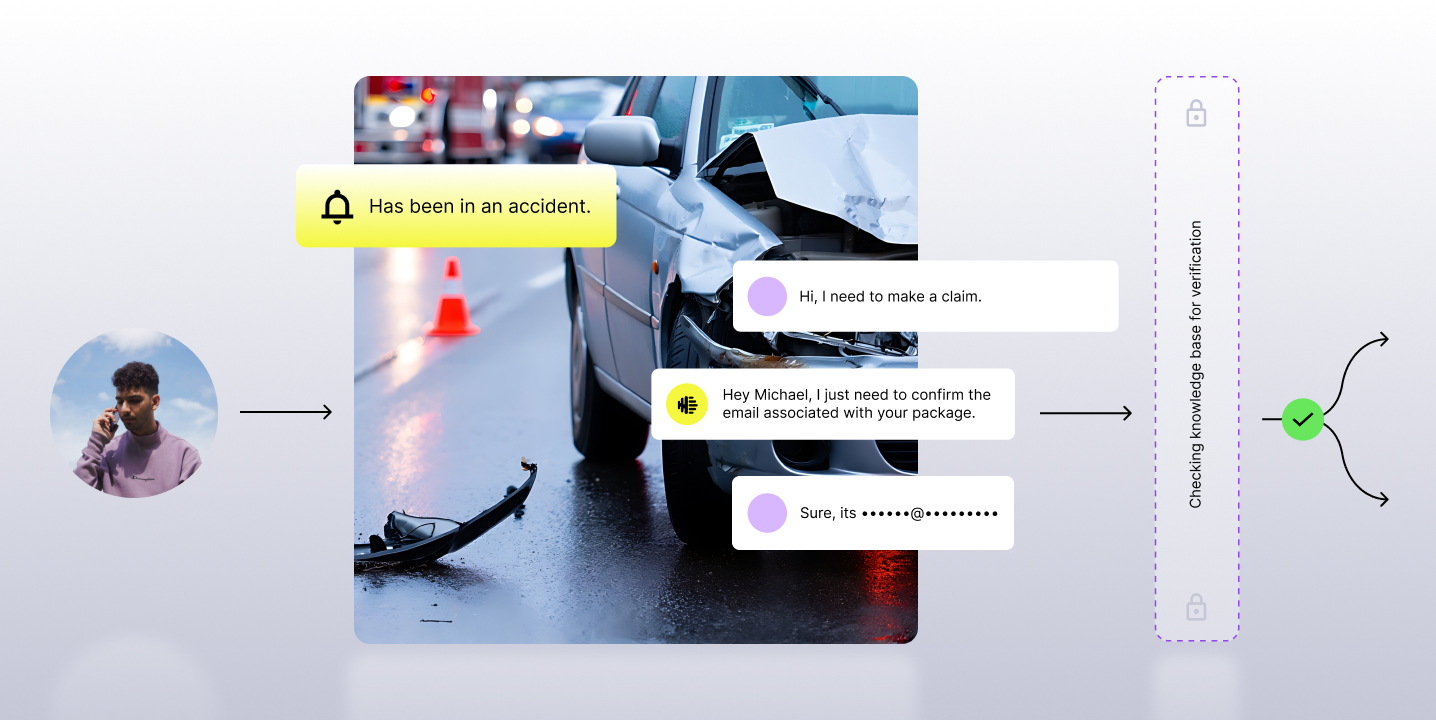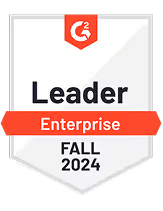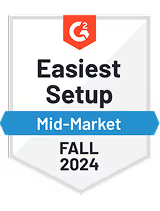Everyone learns differently. But the old way of doing things didn’t account for that.
Agent performance programs were built around a one-size-fits-all approach. Coaching topics were chosen based on perceptions and anecdotes rather than raw data. It wasn’t anyone’s fault - they were making use of the technology and services they had available.
But times have changed. We’ve got a host of AI-services that have completely reshaped the way agent performance is monitored and improved. From 100% of calls being analyzed, to new topics being surfaced and recommended, to tracking progress overtime, we can do things we couldn’t do before thanks to new technologies like machine learning, Natural Language Processing (NLP), and advanced analytics.
“The best-in-class call center is one that is not run from the top down, but an interactive, agent level-driven call center. Agents are the best place to find what you’re doing well and what you’re not.” - Dale Sturgill VP Call Center Operations EmployBridge
Training (the old way) vs. Coaching (the new way)
The old way of doing things we alluded to in the preface? That was training. The transformation we’re witnessing is the move from training to coaching. Let’s look at each to understand their defining differences.
Agent Training
- Planned: We’ll do these trainings once per week
- One-off: Now that we’ve held this training, onto the next topic.
- Not personalized for large group settings: We need to train all of our agents on this specific topic.
Agent Coaching
- Dynamic: Our curriculum is constantly evolving based on the market and our business insights.
- Rapid: Rather than waiting for our weekly training, let’s address this now.
- Collaborative: Let’s work together with our agents to determine the root cause
- Personalized for 1:1 or small groups: Let’s coach our agents in more personalized groups and tailor the sessions to what they need help with most.
Knowing the key differences, let's dive into our 6 step strategy for optimizing agent performance with coaching that works.
The 6 step program for establishing and improving agent performance programs
Step 1: Get in the right mindset
Coaching is human. Your goal is to improve agent performance, their effectiveness at connecting and helping customers, and that’s a very human business. It starts with the right mindset.
- Raise self-awareness: Your agents on the frontlines handle a variety of customers daily. A great coaching program focuses its agent’s attention on specific instances. “Here’s what the customer asked. Here’s how you responded. What could you have done differently?”
- Be proactive: Preparing for pitfalls based on past experiences is a great way to help agents navigate any issues that may arise in the future. Proactive evaluations, analyzing reports, and preparing the agents for similar issues are what a great coaching program delivers. “Oh, this was a close call. What precautions can we take to effectively deal with the situation in the future?”
- Be goal-oriented: Agents are your best brand representatives and also closest to the customers. They can make or break brand perception. One of the biggest goals of a coaching program should involve molding your agents in a way that echoes the brand’s core values. “We want to ensure clients are met by a professional, knowledgeable, and friendly agent.”
- Be action-oriented: Analytics-driven coaching programs help pinpoint blind spots in an agent’s performance, that otherwise would’ve been missed. Designing customized sessions over a generic format that focuses on key problems is more effective in boosting agent performance. “Let’s talk about specific areas we can focus on to move closer to our goal?”
- Be accountable: Completing the feedback loop on a session by measuring the effectiveness of the program is equally important. Transparency and documentation play an important role here. “We trust you to do what you say you will do.”
Step 2: Identify core use cases
With a finger on the pulse of every business interaction taking place, AI-enabled contact centers were capable of quickly creating new and adapting existing coaching programs to better enable their newly remote agents, enabling business continuity across their most critical business drivers.
What business driver is most important to you?
What is a Moment?
A Moment is an interaction that takes place on a conversation, identifiable by natural language processing. A Moment could be monitored by keyword phrase (eg. “Can I speak to your manager” for Supervisor Escalation) or an AI-determined event (eg. negative sentiment).
Step 3: Set your foundations
When it comes to establishing out your agent performance strategy, a simple way to lay out your foundations is who, what, and how.
"One of the really cool things I hear over and over again from different team supervisors is they can address a couple things in the morning, and by noon they know if their team members took what they were coached on and have applied it.” Jason Davis, CCO, ERC
Step 4: Lay out and calibrate your coaching workflow
Now that your foundations are set, the next step is to apply them to your coaching workflow.
WHO: Identify
Goal: Identify top and bottom performing agents across your team.
Strategy: Base decision on data, not hunches by relying on speech analytics insights.
Tactics:
- Agent performance dashboard: a visualization to understand how agents are performing on each monitorable metric.
- Coaching triggers: surfaces what agents are in need of coaching based on recent evaluation scores or time since last coaching session.

WHAT: Prepare
Goal: Focus on the right interactions and deliver targeted coaching based on improvement areas specific to each agent.
Strategy: Personalize coaching conversations based on the needs and goals of individual agents.
Tactics:
- Missed opportunities: see which skills and behaviors agents need to be coached on.
- Trends: track agent performance on any key performance metric overtime
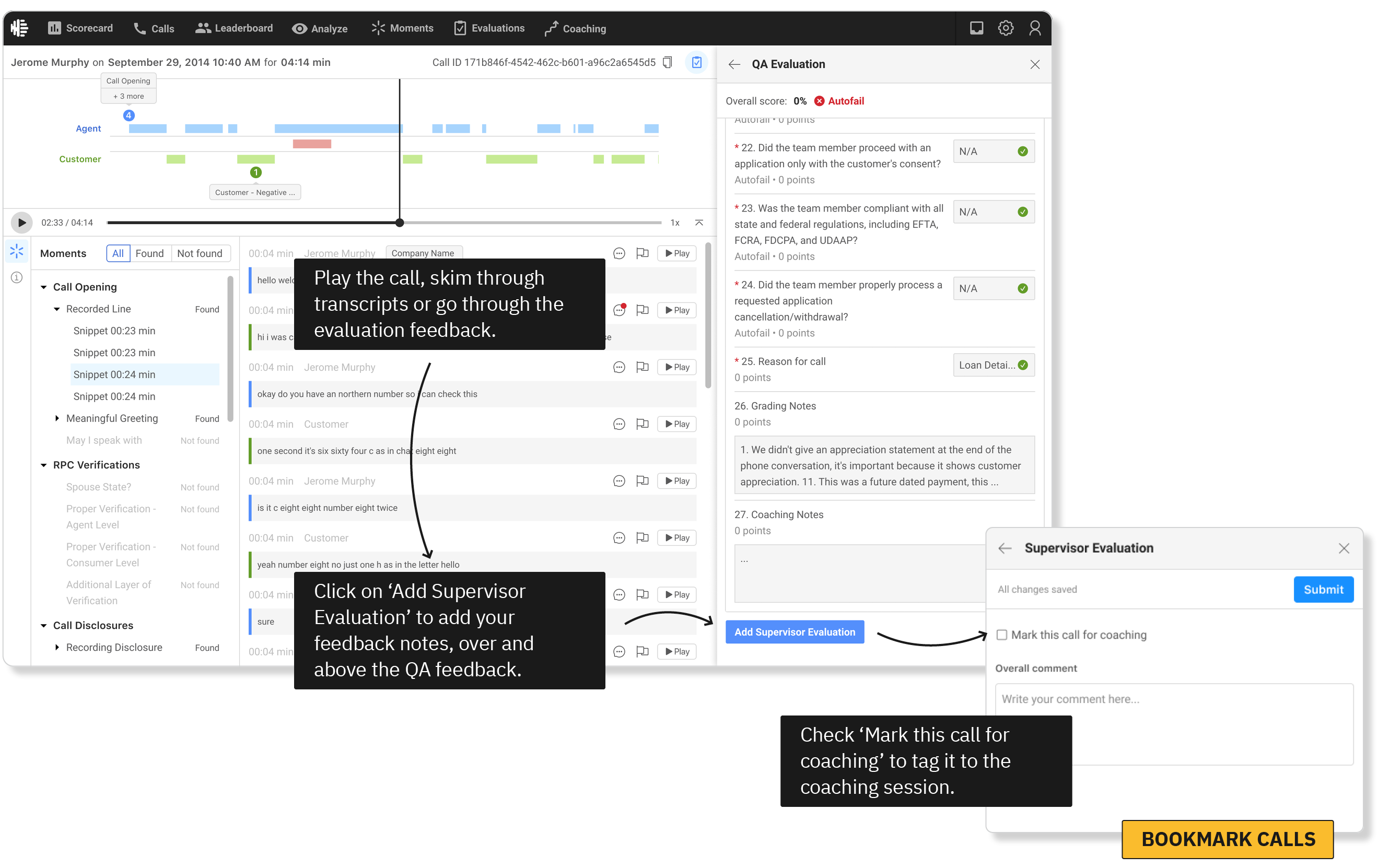
HOW: The Coaching Session
Goal: Make your coaching session more consistent, measurable, and targeted.
Strategy: Connect coaching conversations to operational KPIs or agent behaviors (eg. average handle time), and monitor how and where coaching is making an impact.
Tactics:
- Coaching forms: create consistency in coaching sessions by using a single interface to deliver and document sessions.
- Coaching tags: tag each coaching conversation to a KPI or behavior and monitor progress overtime
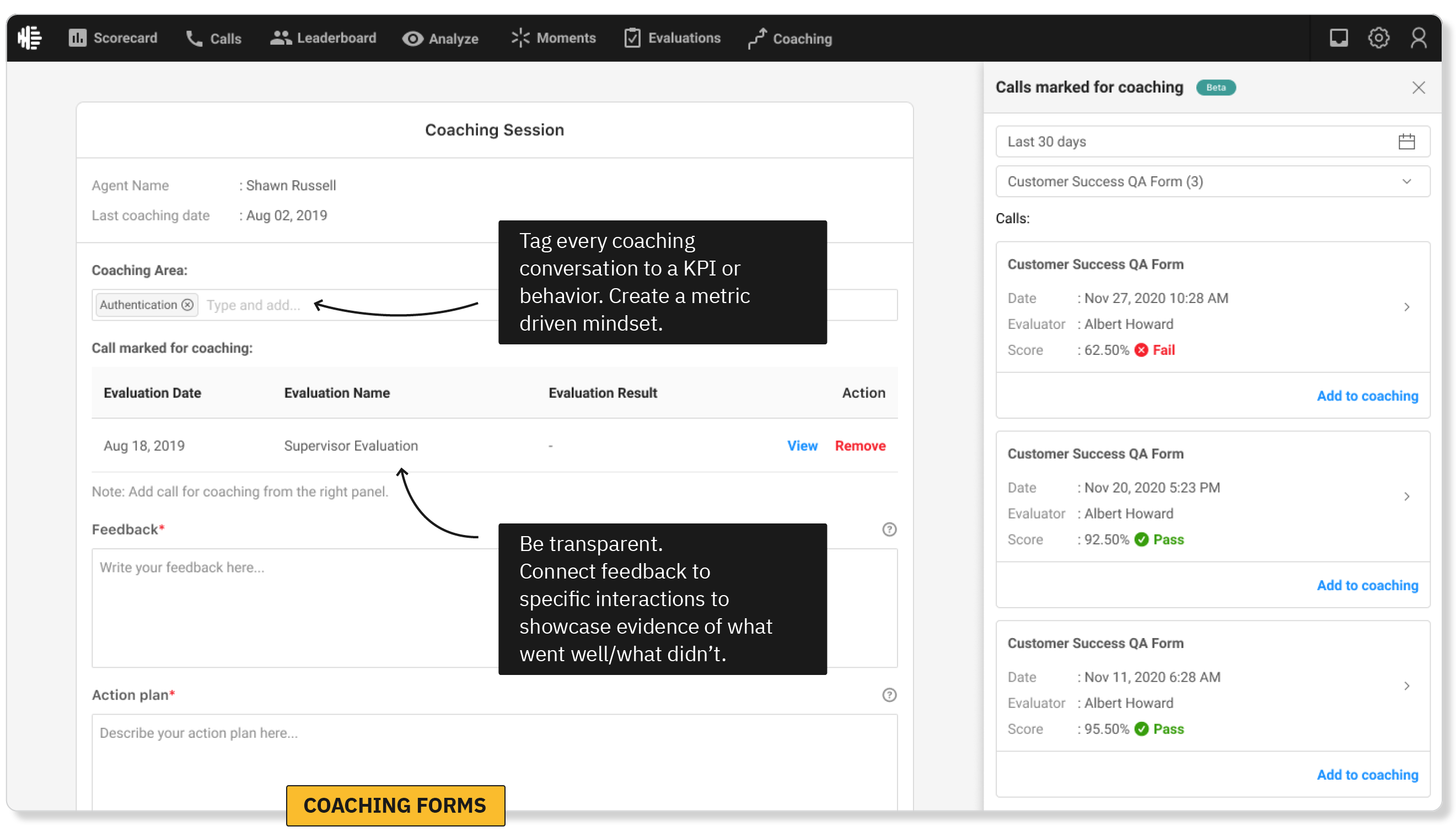
HOW: Reports and Archives
Goal: Monitor agent performance progress overtime
Strategy: Maintain a history of coaching sessions and see how efficient and effective your programs are.
Tactics:
- Coaching archives: track the development of each agent on each KPI and behavior overtime
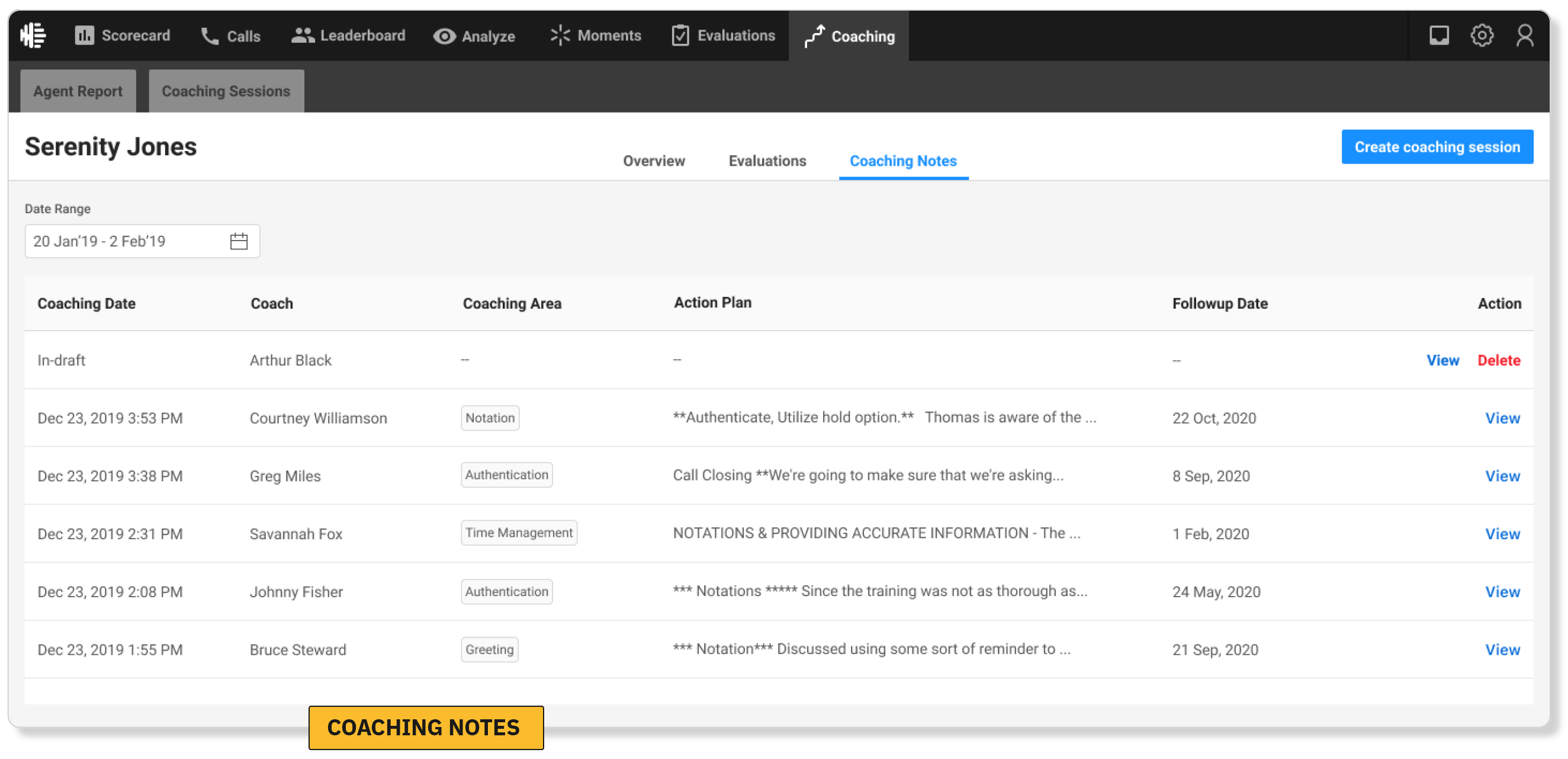
Step 5: Identify and avoid coaching pitfalls
For agents, coaching empowers them to learn new skills and best practices, allowing them to build better rapport with customers and handle more complex queries. This is what moves them from good to great, and gives an organization confidence those agents are acting as their best brand representatives.
But as you continue to scale your coaching programs, we've put together a list of 10 common mistakes that stymie agent performance.
Step 6: Monitor program success and improve overtime
Now that your agent performance programs are up and running, it’s critical to continue to improve your programs overtime (just like your agents).
Rely on QA evaluations to drive more impactful coaching sessions:
- On-the-spot coaching: When you're able to do your evaluation side-by-side with your call transcript and call recording, you can pinpoint the exact moment you want to coach on, allowing the agent to see the behavior that needs correction.
- Detailed coaching: Citing specific instances, Auto QA can provide supervisors direct notes for agents, backed with additional resources, allowing supervisors to more clearly convey feedback to agents.
Identify and coach on the empathy statements that work best
With keyword phrase monitoring, paired with sentiment analysis, you can see what phrases lead to positive results. This information can be aggregated and used for team-wide coaching sessions on empathy statements and other agent soft skills.
Utilize micro-coaching for rapid feedback (and be proactive!)
Get agile with coaching programs. If there’s an issue, address it immediately and don’t let it get worse over time. The agent may not know it’s happening. On top of that, quickly pinpoint an area where one agent or a small group of agents need assistance and train them with bite-sized content.
For example, perhaps a supervisor notices that some agents have not adopted mandatory compliance dialogues - this must be addressed immediately. There's no time to wait.
The speed in which we’re able to react to what’s happening is critical, and we continue to aim to reduce it. Take a scenario where an agent is coached on compliance days (or up to a week) after an evaluation is completed. There could be severe fatal errors in that time period that need to be addressed, that simply aren't. - Neal Topf, President, Callzilla
Encourage peer coaching programs
You already know your top performers. Encourage them to take part in peer coaching, small group trainings, or 1:1 virtual trainings. Additionally, roll out new training content featuring top agent’s go-to talk tracks and call snippets.
Root Insurance used the following best practices to drive more engagement and interaction during virtual coaching/training sessions:
- More frequent check-ins to see if everyone was tracking.
- Google quizzes to ensure everyone grasped the information they’d just received.
- Break-out discussions over Google Hangouts to apply the information with peers.
- Digital shadowing of more seasoned agents.
- Targeted micro-coaching sessions for seasoned agents who needed to adopt new talk tracks and processes overnight due to the shifting nature of COVID-19.
Celebrate achievements - don’t just course correct
With so many insights for every agent, you have the opportunity to not just course correct behaviors, but celebrate the great work your agents do. Leaderboards showcase your best agents, and arm you with data to truly celebrate their successes.
Remember, agent experience = customer experience.
Wrapping up and looking forward
Only 13% of executives in HBR research say they are “very effective” in delivering a personalized and seamless customer experience. And 66% of contact centers are still manually analyzing customer experience.
Yikes. We can do better than that. And as you’ve gathered from reading through this blog post, there are proven ways to do it.
By approaching agent performance with a data-driven, personalized, transparent, and consistent approach, the payoff is huge.
- Less time on data aggregation, more time coaching
- Less agent attrition, more agent engagement and retention
- Better performance across all contact center metrics and KPIs
- An ever-increasing NPS











